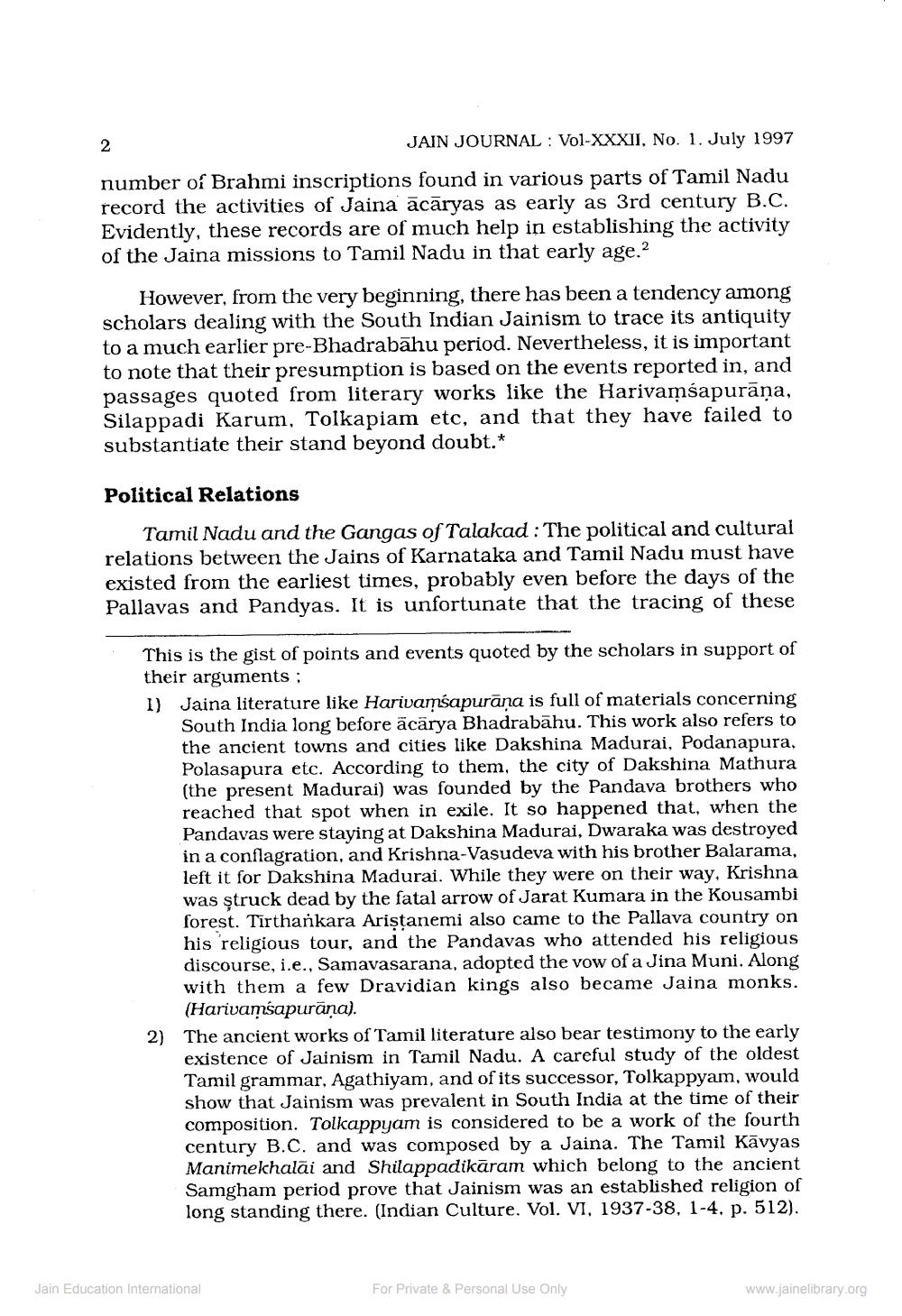Book Title: Jain Journal 1997 07 Author(s): Jain Bhawan Publication Publisher: Jain Bhawan Publication View full book textPage 7
________________ JAIN JOURNAL : Vol-XXXII, No. 1. July 1997 number of Brahmi inscriptions found in various parts of Tamil Nadu record the activities of Jaina ācāryas as early as 3rd century B.C. Evidently, these records are of much help in establishing the activity of the Jaina missions to Tamil Nadu in that early age.2 However, from the very beginning, there has been a tendency among scholars dealing with the South Indian Jainism to trace its antiquity to a much earlier pre-Bhadrabahu period. Nevertheless, it is important to note that their presumption is based on the events reported in, and passages quoted from literary works like the Harivamsapurāņa, Silappadi Karum, Tolkapiam etc, and that they have failed to substantiate their stand beyond doubt.* Political Relations Tamil Nadu and the Gangas of Talakad: The political and cultural relations between the Jains of Karnataka and Tamil Nadu must have existed from the earliest times, probably even before the days of the Pallavas and Pandyas. It is unfortunate that the tracing of these This is the gist of points and events quoted by the scholars in support of their arguments : 1) Jaina literature like Harivamsapurāna is full of materials concerning South India long before acārya Bhadrabahu. This work also refers to the ancient towns and cities like Dakshina Madurai, Podanapura, Polasapura etc. According to them, the city of Dakshina Mathura (the present Madurai) was founded by the Pandava brothers who reached that spot when in exile. It so happened that, when the Pandavas were staying at Dakshina Madurai, Dwaraka was destroyed in a conflagration, and Krishna-Vasudeva with his brother Balarama, left it for Dakshina Madurai. While they were on their way, Krishna was struck dead by the fatal arrow of Jarat Kumara in the Kousambi forest. Tirthankara Ariştanemi also came to the Pallava country on his religious tour, and the Pandavas who attended his religious discourse, i.e., Samavasarana, adopted the vow of a Jina Muni. Along with them a few Dravidian kings also became Jaina monks. (Harivamsapurāna). The ancient works of Tamil literature also bear testimony to the early existence of Jainism in Tamil Nadu. A careful study of the oldest Tamil grammar, Agathiyam, and of its successor, Tolkappyam, would show that Jainism was prevalent in South India at the time of their composition. Tolkappyam is considered to be a work of the fourth century B.C. and was composed by a Jaina. The Tamil Kavyas Manimekhalāi and Shilappadikāram which belong to the ancient Samgham period prove that Jainism was an established religion of long standing there. (Indian Culture. Vol. VI, 1937-38, 1-4, p. 512). 2) Jain Education International For Private & Personal Use Only www.jainelibrary.orgPage Navigation
1 ... 5 6 7 8 9 10 11 12 13 14 15 16 17 18 19 20 21 22 23 24 25 26 27 28 29 30 31 32 33 34 35 36 37 38 39 40 41 42 43 44 45 46 47 48 49 50
